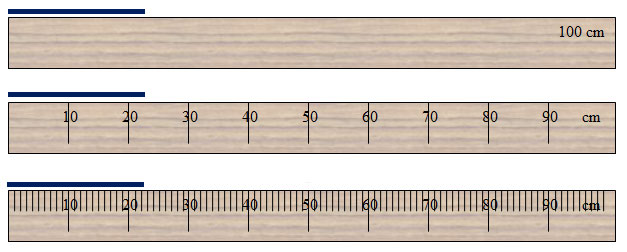

Above are three meter sticks broken down into different units: 1 meter, 10 units of 10 centimeters each, and 1-centimeter segments. The most precise measurement that can be made with the first stick is 1 meter. The second stick has a precision of 10 centimeters, and finally, the last stick has a precision of 1 centimeter.
If the first meter stick is used to measure the length of the blue line, an accurate reading cannot be made because the length is less than 100cm. By using the second stick, an approximate guess can be made that the length is over 20cm. Finally, the third meter stick shows that the length of the blue line is about 22 centimeters.
In scientific work higher precision levels are needed. Scientists express the level of precision by using significant figures. Let’s zoom in on the ruler and measure the object again.

Now that you have a better view of the object and ruler, you can see that the object is 22.5cm.
22.5cm is a more precise number than the measurements that were taken before. The precision of the measurement 22.5cm is 3 significant digits. When you are working out mathematical or scientific problems, you will need to know what level of precision or significant digits your answer should have. Significant figures of a number are the digits that contribute the precision of the number.
Because measurement requires human involvement, no measurement is exact. Measurements should include all accurately measured values and one uncertain digit (the last digit).
![]() Looking at the ruler example above, what digit was uncertain? Click on the digit that was uncertain.
Looking at the ruler example above, what digit was uncertain? Click on the digit that was uncertain.